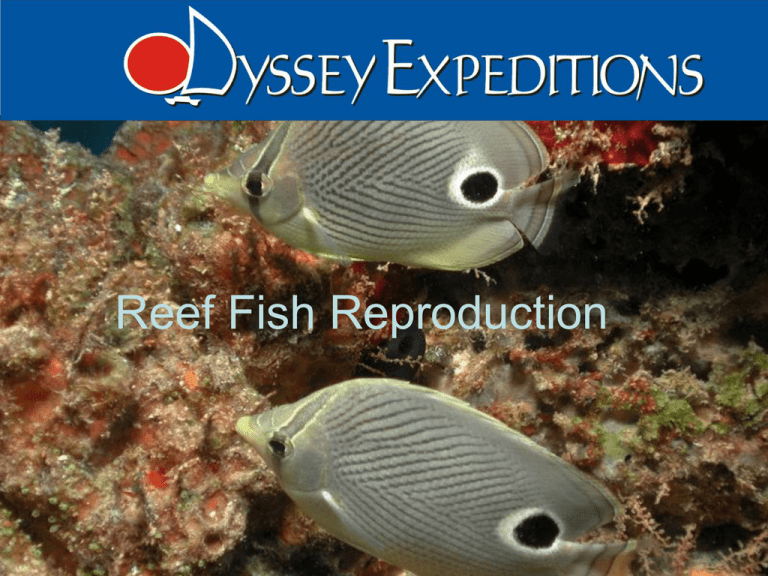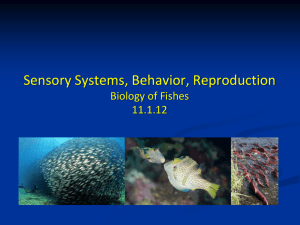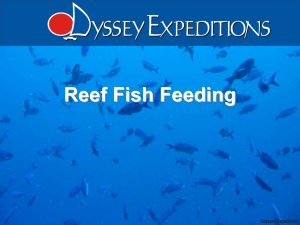
Reef Fish Reproduction
Odyssey Expeditions – Fish Reproduction
1
Introduction
• Great diversity in reproduction
patterns of fishes
• Many change gender
• Some mate for life while others are
promiscuous
• Different strategies have
developed in order to reach a
common goal - to have the
greatest number of young survive
to reproduce
• The larger the individual the more
gametes produced
Odyssey Expeditions – Fish Reproduction
Odyssey Expeditions
2
Reproduction Modes
• Oviparity - external development
– Lay undeveloped eggs
– External fertilization (most all bony fishes)
– Internal fertilization (some cartilaginous fishes)
• Ovoviviparity – internal development
– No direct nourishment from mother (fert. eggs carried)
– Advanced at birth (some cartilaginous fishes)
– Larval birth (few bony fishes)
• Viviparity – internal development
– Direct maternal nourishment (placental)
– Fully advanced at birth (adv. sharks and few bony fish)
Odyssey Expeditions – Fish Reproduction
3
Oviparity
• Most common
• Lower energy cost to produce eggs
• Survival is low, millions produced in
hopes that at least one will survive
to reproduce
• Larval fishes typically spend 14 –
30 days feeding among the
plankton clouds.
• Juveniles typically settle in areas
far from where they were spawned
due to dispersal from the currents
Odyssey Expeditions – Fish Reproduction
Odyssey Expeditions
4
Ovoviviparous/Viviparous
• Eggs have lower rate of
predation when carried in
mother
• Much higher energy cost per
egg
• Therefore fewer eggs produced
• Young born as miniature adults
• Young generally stay in the
same area as mother
Odyssey Expeditions
Odyssey Expeditions – Fish Reproduction
5
Reproductive Strategies
• Broadcast spawning
– Majority of bony fishes
– Release thousands to millions of tiny eggs into water column
• Benthic egg laying
– Some bony fishes
– Tens to thousands of eggs laid in nest
• Live-bearing
–
–
–
–
Few bony fishes
Most cartilaginous fishes
Young emerge from parent free swimming
Few young produced
• More parental care = less eggs
• Goal is to have maximum number of young reproduce
Odyssey Expeditions – Fish Reproduction
6
Broadcast Spawners
• Generally occurs at dusk
(fewer predators around)
• Typically done on an outflowing tide to get eggs away
from predators on the reef
• Typically performed at a
specific site
• May migrate to areas of large
congregations (snappers,
groupers) or stay on resident
reef
• Gamete production lowest in
energy cost per gamete
Odyssey Expeditions – Fish Reproduction
Migration and Congregation
NOAA
7
Broadcast Spawners
• Males and females make an
upward dash and release
gametes, called spawning
rush
• Egg and sperm meet in water
column
• Hundreds to thousands of
eggs released in each dash
• Higher level of polygamy, but
pair spawning common
Odyssey Expeditions – Fish Reproduction
Spawning Rush
8
Broadcast Spawners
• Fertilized eggs at mercy of currents
• Hatch after ~24 hours
• Larvae live off yolk after hatching for a
short time
• Larvae may be spined to reduce
predation.
• Survival is very low
• Theorized that they are able to locate
settling habitat by sound and smell
• Settle onto reef at night
Larvae with yolk
NOAA
Odyssey Expeditions – Fish Reproduction
9
Benthic Egg Layers
•
•
•
•
Oviparous
Typically spawned at daybreak
Fishes generally small in size
High energy cost to males who
prepare nests and tends the eggs
(remove debris, defend eggs)
Sergeant major tending eggs
– Way to ensure he is the only one to
fertilize eggs (he hopes)
• Female deposits eggs in nest built
by male
• Males come along periodically and
fertilizes them
• Nests may have more than one
females clutch
Odyssey Expeditions – Fish Reproduction
Breeding
10
Benthic Egg Layers
• No migration or surface dash
risks
• Larvae developed after ~7 days
and generally begin a planktonic
existence for dispersal and
feeding.
• Male jawfishes and some
cardinalfishes keep eggs in
mouths.
• Male sygnathids (seahorses and
pipefishes) brood eggs in a
pouch
Odyssey Expeditions – Fish Reproduction
Jawfish with eggs
11
Live-Bearers
• Very few bony fishes
• Typically cartilaginous
fishes
• Viviparous and
Ovoviviparous
• Fertilization internal
• Sperm transferred into
cloaca (opening used for
excretion and
reproduction) by the
males claspers (modified
pelvic fin)
Odyssey Expeditions – Fish Reproduction
Internal fertilization
12
Live-Bearers
• Sperm fertilizes few eggs
• In hammerhead and
requiem families
(viviparous) young may
be cannibalistic, eating
other young and eggs in
the womb.
• Gestation period of 6 to
22 months.
• Birth to live young
Odyssey Expeditions – Fish Reproduction
Birth of live young
13
Breeding Chances
• Semelparous – spawn once then die
– Ex. Lamprey, salmon
• Iteroparous – spawn more than once
– most fishes
Odyssey Expeditions – Fish Reproduction
Semelparous salmon
14
Mating Systems
• Promiscuous – both sexes have
multiple partners (mass spawning
events, nassau grouper)
• Polygamous – one sex has multiple
partners
Polygyny Harem
– Polygyny – males have multiple
partners (most common)
• Harem formation – male has breeding
right to group of females (wrasses)
– Polyandry – females have multiple
partners (uncommon)
Monogamous
• Monogamous – sexes have one
partner (butterflyfishes,
anglefishes)
Odyssey Expeditions
Odyssey Expeditions – Fish Reproduction
15
Genders
• Gonochroistic – sex is fixed, one sex
(most fishes)
• Hermaphroditic – contain both sex
organs at some point
– Simultaneous – both sexes at
once (deep water fishes, hamlets)
– Sequential – changes sex
• Protandrous – male into female
(moray eels)
• Protogynous – female into male
(most common)
– wrasses, parrotfishes
Odyssey Expeditions – Fish Reproduction
Jon Buchheim
16
Secondary Characteristics
• Monomorphic – no visible external
differences between sexes (most fishes)
• Dimorphic – Visible external differences
– Male typically more colorful and ornate
– May be permanent or only during spawning
– Wrasses, blennies, parrotfishes
Female
Male
NOAA
Odyssey Expeditions – Fish Reproduction
17
Courting
•
•
•
•
•
Aids in species recognition
Pair bonding
Spawning site orientation
Synchronous gamete release
Overcome territorial
aggression
• May be simple or complex
– Change color, make sounds,
“dance”
Odyssey Expeditions – Fish Reproduction
18
Alternative Mating Strategies
• Satellite males – Mimic female behavior and
coloration
– Move into nest of male and releases sperm without
the immediate attention of the male
• Sneaker males – Generally smaller and
immature in appearance (may look like females)
– remain hidden and then dart through nests or
spawning rush and deposit sperm on the fly.
– Able to release sperm without guarding male stopping
them
Odyssey Expeditions – Fish Reproduction
19
References
• Buchheim, Jason. Tropical Marine Biology. 1995
• Deloach, Ned and Paul Humann. Reef Fish Behavior: Florida Caribbean
Bahamas. Florida: New World Publications, Inc.,
1999
• Helfman, Gene, Bruce Collette, and Douglas Facey. The Diversity of
Fishes. Massachusetts: Blackwell Publishers, 1997
• Spying on the sex lives of wild fish – Reproduction – Brief Article.
June 2002.
USA Today (Society for the Advancement of
Education). 11 Jan. 2007
http://findarticles.com/p/articles/mi_m1272/is_130/ai_8770633
Odyssey Expeditions – Fish Reproduction
4
20










